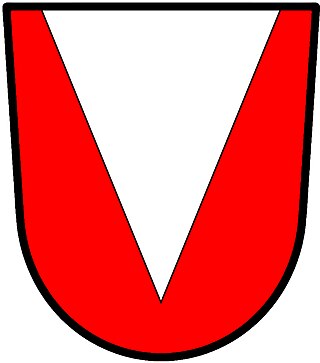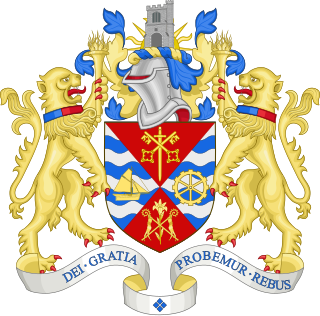
The lines in heraldry used to divide and vary fields and charges are by default straight, but may have many different shapes. Care must be taken to distinguish these types of lines from the use of lines as charges, and to distinguish these shapes from actual charges, such as "a mount [or triple mount] in base," or, particularly in German heraldry, different kinds of embattled from castle walls.

In heraldry, variations of the field are any of a number of ways that a field may be covered with a pattern, rather than a flat tincture or a simple division of the field.
Ordinaries in heraldry are sometimes embellished with stripes of colour alongside them, have lumps added to them, shown with their edges arciform instead of straight, have their peaks and tops chopped off, pushed up and down out of the usual positions, or even broken apart.

In heraldry, an ordinary is a one of the two main types of charges, beside the mobile charges. An ordinary is a simple geometrical figure, bounded by straight lines and running from side to side or top to bottom of the shield. There are also some geometric charges known as subordinaries, which have been given lesser status by some heraldic writers, though most have been in use as long as the traditional ordinaries. Diminutives of ordinaries and some subordinaries are charges of the same shape, though thinner. Most of the ordinaries are theoretically said to occupy one-third of the shield; but this is rarely observed in practice, except when the ordinary is the only charge.

The coat of arms of Toronto, Ontario, Canada, was designed by Robert Watt, the Chief Herald of Canada at the time, for the City of Toronto after its amalgamation in 1998. The arms were granted by the Canadian Heraldic Authority on 11 January 1999.

The current coat of arms of Zimbabwe was adopted on 21 September 1981, one year and five months after the national flag was adopted. Previously the coat of arms of Zimbabwe was identical to the former coat of arms of Rhodesia.

The coat of arms of Sunderland is the official heraldic arms of the City of Sunderland.

The flag of the British Antarctic Territory was granted on 21 April 1998. It features the coat of arms granted on 1 August 1963, a year after the British Antarctic Territory, a British Overseas Territory, was created. Previously, the Territory was a part of the Falkland Islands Dependencies and used the same flag. On 30 May 1969, a blue ensign with the British Antarctic Territory coat of arms in the fly was introduced as a civil ensign.

The coat of arms of Sierra Leone, were developed by the College of Arms and granted in 1960.

The coat of arms of the Federation of Rhodesia and Nyasaland was designed by M.J. Morris and was granted by Royal Warrant on 22 July 1954.

The coat of arms of the British Antarctic Territory was first granted in 1952, when the territory was still a dependency of the Falkland Islands.

The coat of arms of Kenya features two lions, a symbol of protection, holding spears and a traditional East African shield. The shield and spears symbolize unity and defence of freedom. The shield contains the national colours, representing:

In heraldry and heraldic vexillology, a blazon is a formal description of a coat of arms, flag or similar emblem, from which the reader can reconstruct the appropriate image. The verb to blazon means to create such a description. The visual depiction of a coat of arms or flag has traditionally had considerable latitude in design, but a verbal blazon specifies the essentially distinctive elements. A coat of arms or flag is therefore primarily defined not by a picture but rather by the wording of its blazon. Blazon is also the specialized language in which a blazon is written, and, as a verb, the act of writing such a description. Blazonry is the art, craft or practice of creating a blazon. The language employed in blazonry has its own vocabulary, grammar and syntax, which becomes essential for comprehension when blazoning a complex coat of arms.

The coat of arms of the Extremadura is described in the Title I of the Spanish Law 4 of June 3, 1985, the Law of the coat of arms, flag and regional day of Extremadura.

In heraldry, a pile is a charge usually counted as one of the ordinaries. It consists of a wedge emerging from the upper edge of the shield and converging to a point near the base. If it touches the base, it is blazoned throughout.

In heraldry, a bar is an ordinary consisting of a horizontal band across the shield. If only one bar appears across the middle of the shield, it is termed a fess; if two or more appear, they can only be called bars. Calling the bar a diminutive of the fess is inaccurate, however, because two bars may each be no smaller than a fess. Like the fess, bars too may bear complex lines. The diminutive form of the bar is the barrulet, though these frequently appear in pairs, the pair termed a "bar gemel" rather than "two barrulets".

The coat of arms of the London Borough of Barking and Dagenham is the official coat of arms of the London Borough of Barking and Dagenham, granted on 1 September 1965.

The coat of arms of the London Borough of Hackney is the official heraldic arms of the London Borough of Hackney. The coat of arms were granted on 25 July 1969.

The coat of arms of Oxford is the official heraldic arms of Oxford, used by Oxford City Council.

The Bedfordshire flag is the flag of the English county of Bedfordshire. It is based on the banner of the arms of the former Bedfordshire County Council, which was granted the arms in 1951 by the College of Arms. This design was adopted as the flag of the historic county in September 2014, with the support of the High Sheriff of the county.





















